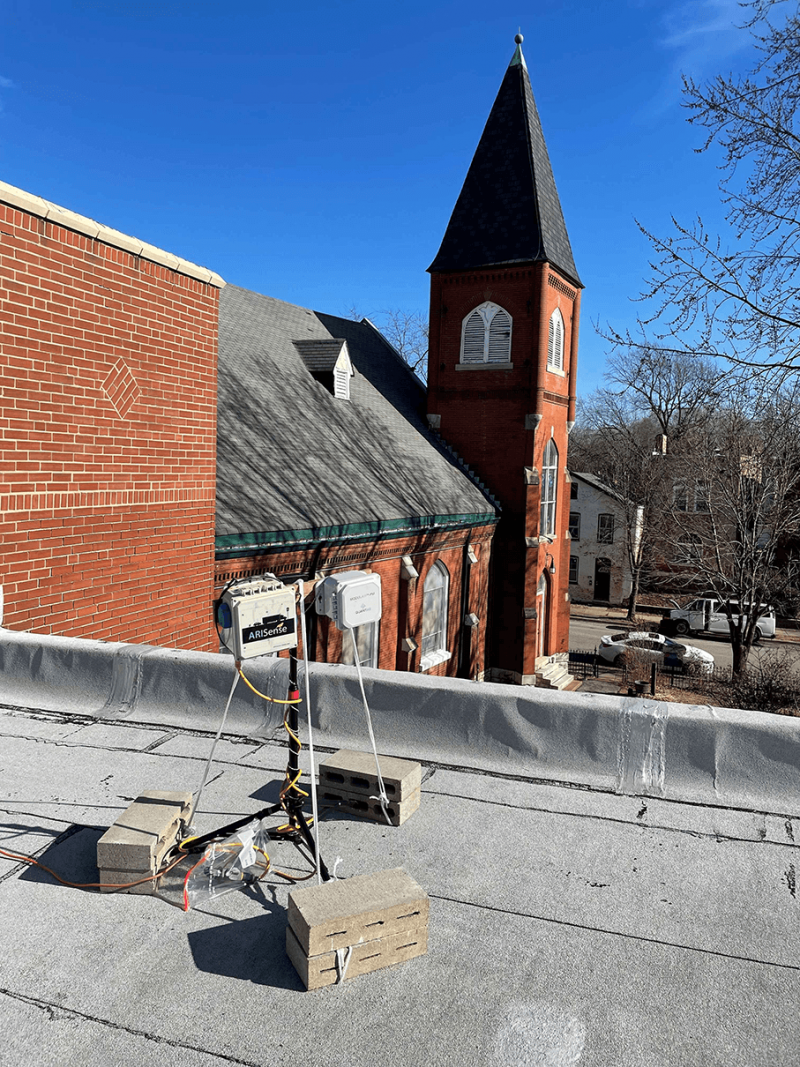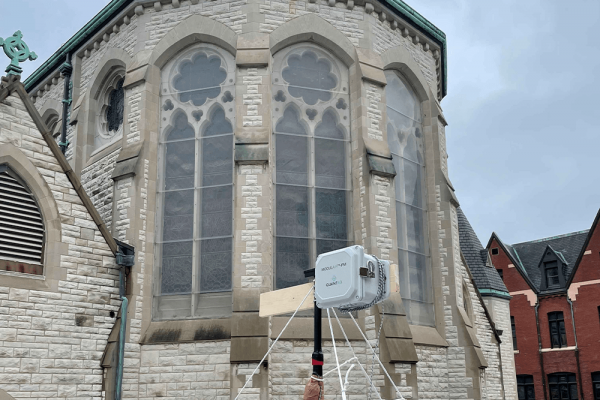A couple years ago, urban farmer DeAndress Green drove Uber and DoorDash for 10 hours straight and then returned to her home on the southside of St. Louis struggling to breathe.
“I thought I was having an asthma attack,” she said.
She tried drinking coffee, her family’s quick trick for calming wheezing. She found her nephew’s inhaler and took that, which helped. She went to the hospital, where medical professionals tested for asthma. It wasn’t her first asthma test or emergency room visit due to breathing difficulties, and the results hadn’t changed: She didn’t demonstrate the right characteristics for a diagnosis.
“They’ve never learned why I’m wheezing,” said Green. “They’ve only said it’s probably environmental, which makes me very angry because I don’t know when it’s going to happen.” It also means doctors have been unwilling to prescribe her an inhaler.
Green wonders what toxins she’s been exposed to all her life. She gets nervous when she goes to north St. Louis, or commutes through Sauget, Ill., where a hazardous waste incinerator is located. Growing up, she recalls an odd, sweet smell while playing sports in empty lots in her neighborhood. Her mother Clye James Verde, who worked as a residential manager and groundskeeper at a housing project, received an asthma diagnosis after using an industrial strength oven cleaner during a shift — Verde didn’t know they should have worn a mask and gloves.
Green and Verde’s story is similar to many others who share their demographics: Black St. Louisans are more likely to live near major highways and interstates and known polluters, and Black children and youth are 10 times more likely than white counterparts to visit emergency rooms for asthma treatment, according to the Missouri Department of Health and Social Services.
Black residents have been at the forefront of the fight to address air quality for decades. Green remembers her mother advocating to ensure her kids’ access to their inhalers and other asthma management in schools. But now, Green said, Black St. Louisans aren’t the only ones raising their voices on air quality. Green joined Metropolitan Congregations United, a local faith and advocacy organization.
“For once in my lifetime, we have people who don’t look like me speaking about this,” she said. Over 2022-23, MCU organized 15 churches to help researchers better understand air quality in St. Louis.
“This is a way to put your faith into action. If your faith teaches you to care for creation, what does that ministry look like?” said Beth Gutzler, lead environmental justice organizer at Metropolitan Congregations United. “It’s a little different than other ministries look. Some people do food pantries, some people fight food injustice.” And more frequently, St. Louis churches are prioritizing tackling air quality.
Using air monitors as a tool for action
Currently, Missouri operates eight Environmental Protection Agency air monitors across St. Louis city and St. Louis County — only one of which provides a comprehensive screening of pollutants. The data is not granular enough to illuminate neighborhood disparities on local air pollution, so, advocates for air quality improvements have little information with which to petition decision-makers.
The Jay Turner Group, an energy, environmental, and chemical engineering lab at Washington University in St. Louis, received a community grant to pursue a slice of this problem and installed QuantAQ monitors. The low-cost sensors track particulate matter, which comes from car exhaust, fossil-fuel power plants, construction dust, industrial activity and other sources. Particulate matter can vary depending on weather and the built environment, which is why neighborhood-specific data would help address clean-air disparities.
The Group worked with Metropolitan Congregations United, who recruited 15 congregations across the city to install the monitors. MCU is a regional organization that helps congregational leaders build collective power to address racial inequities. Churches offered a good location for consistent monitoring, whereas monitors at park locations tend to get unplugged, said Gutzler.240822-epiphany_united_church_of_christ_1.png

At $1,250, the monitors are vastly cheaper than EPA monitors, which cost thousands more. The sensors report data to remote servers via cellular connection, making them more accessible than Wi-Fi. The project measured at each site between 2022-2023.
Tyler Cargill, a doctoral student who helped churches understand the data from the monitors, said MCU’s community engagement played a role in the research.
“One of the main reasons we do this is to help people to understand what they can get out of these sensors,” he said. “We test them to be able to understand: What are their limitations? What are their strengths?”
Spurring community engagement
For Beth Gutzler, lead environmental justice organizer at Metropolitan Congregations United, a major success of the project is the new and renewed engagement of churches in air quality issues.
For New Northside Missionary Baptist Church, one of the churches that installed monitors, clean air has been on their radar for many years now, said Rev. Rodrick Burton. During a campaign to support the Obama administration’s Clean Power Plan, Burton recalls a church event where he asked his congregation to raise their hand if they or a family member had asthma. He recalls about 40 percent of attendees lifting a hand. “That kind of got everyone’s attention,” he said.
Since then, the church has installed solar panels, held a Green the Church summit, helped members access inhalers for asthma, and hosted EPA administrators. As a church leader, Burton has participated on local clean air advisory committees and attended national conferences with organizations like Moms Clean Air Force.
“Our belief is that as Christians we are to be good stewards of the resources that God has provided. It would be sinful for us to take what has been provided for all and not protect the universal use for everyone,” Burton said. He views clean air as a justice issue — “a universal right.”
Allowing scientists to collect data using church property was a natural fit for a Black church, he said, comparing it to Civil Rights activists who documented and demonstrated evidence of systemic racism in court cases like Brown v. Board of Education.
Air monitors were also located at churches that were not previously engaged on environmental issues. For these churches, the research helped begin a conversation about what neighborhood ministries can look like — sometimes including creation care for the first time.
“It’s different than Sierra Club,” said Gutzler, who attends Sts. Joachim and Ann Catholic Church in St. Charles. “I get to tie it to the doctrines and teachings of their faith.”
Congregations have dialogued about hosting a neighborhood lawn mower rental program to help with the transition from gas to electric, addressing indoor air quality by replacing kitchen gas appliances, and even divesting from fossil fuels in church-held investment portfolios, Gutzler said.
The air monitors also helped churches dive deeper into structural issues, moving from caring for community members with asthma to asking how they could work to improve air quality.
What to do with unexpected outcomes
The common view was that monitors would reveal higher rates of pollution in north St. Louis, which ranks high on the CDC’s environmental justice index. But Cargill said the data captured didn’t support that, with increases in PM2.5 (the particulate matter tracked) near roadways or buildings, not specific neighborhoods.
The data still proved useful for addressing clean-air access, however: Most of the monitors found PM2.5 levels near or above the EPA’s threshold for exposure, and well above the World Health Organization’s recommended threshold. This means likely all St. Louis residents are at risk for negative health impacts.
Cargill said future studies could still help address neighborhood discrepancies by measuring ozone. The monitors they used could not detect ozone, which can exacerbate asthma when it forms at ground level. Ozone develops generally on sunny, hot days, as a reaction of nitrogen oxide, from sources like tailpipes and construction, and compounds found in gas, paint, solvent, and even pine trees, Cargill said. But the current cost of these monitors likely keeps them out of reach for churches.
From knowledge to advocacy
To begin public advocacy, MCU asked for more transparency in community outreach from the Missouri Department of Natural Resources, who regulates air quality in the state.
Previously the agency only allowed public involvement in construction permits related to air emissions when the public requested. In other words, projects sailed through permitting without public notice. You could not even see the permit that you might want to request a hearing about, said Gutzler. To appeal, a citizen had to make a public records request.
Now, the department maintains an automatic email list of upcoming permits, though a citizen still needs to request a hearing. Gutzler counts it as a win. It is the first step in her vision of helping congregations to engage the community and together become the watch dogs that pay attention to air quality in the permit process.
With more awareness of how to navigate the public process, MCU testified against an incinerator permit in Hannibal, upriver from St. Louis. Their efforts were ultimately unsuccessful — the permit was approved — but it gave them an idea of how to engage across the rural-urban divide, particularly as they hope to engage churches across the state.
For some congregations, the air monitors also focused community concerns on finding the right solutions. Cargill crossed off PM2.5 as the culprit causing odors that plague the Benton Park neighborhood, where Epiphany United Church of Christ placed a monitor.
At a public meeting in April, Doris McCarter, a plant scientist and congregant at Epiphany, asked Missouri regulators to use their authority to push for stricter EPA regulations and request a study that identifies the source of the odor and its potential health effects, even though it may be an Illinois plant.
Meanwhile, Epiphany member Kathleen Logan Smith formed Breathe Better STL, which meets at the church monthly to explore how to grow a movement to oppose air permits that allow exceptions for exceeding EPA emission limits.
Ultimately, community air monitors helped spur a growing interest in clean air advocacy among churches in Missouri. When the Washington University project ended, MCU helped find funds to cover lower-cost PurpleAir Network monitors for churches to “help fill out the St. Louis map,” said Gutzler. One strength of the PurpleAir Network is the open-source geographic data on air quality, but some residential areas — particularly in environmental justice communities — remain unmeasured.
The group also partners with the Heartland Environmental Justice Center, an EPA-funded research center, and the Gamaliel Network, which provides training on faith-based advocacy.
Gutzler aspires to engage the whole state of Missouri on air quality issues and help scientists and church leaders to see the potential for change that comes through working together.
Got something to say about what you're reading? We value your feedback!







